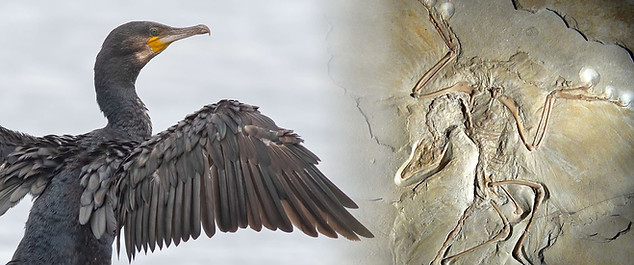Origins of modern bird characteristics
How did key avian features like feathers, flight, enlarged brains, a toothless beak, warm-bloodedness, and even present-day geographic distributions arise? We are interested in applying cutting-edge approaches to these classic macroevolutionary questions.
Key papers: Field et al. 2025 ; Chiappe, Navalón et al. 2024 ; Benito et al. 2022a; Ducatez & Field 2021; Brocklehurst & Field 2021; Dawson et al. 2020; Saupe et al. 2019; Field et al. 2018a; Faux and Field 2017; Feo et al. 2015

Vertebrate evolutionary morphology
Imaging advances have revolutionised the study of vertebrate morphology. We apply high resolution visualisation methods to study the evolution of form and function in several vertebrate groups.
Key papers: Kuo et al. 2024 ; Rico-Guevara et al. 2024 ; Widrig et al. 2023 ; Kuo et al. 2023 ; Steell et al. 2023 ; Burton et al. 2023 ; Benito et al. 2022b ; Demuth et al. 2022 ; Watanabe et al. 2021 ; Field et al. 2020a ; Field et al. 2018a

Phylogeny and divergence times of birds and other vertebrates
We try to unravel avian phylogenetic interrelationships, and attempt to understand where key fossils sit on the bird tree of life. These efforts aim to resolve several evolutionary mysteries related to how and when modern bird diversity arose. Our work has suggested that the modern bird group is younger than long-assumed, with many major groups arising rapidly in the early Cenozoic.
Key papers: Berv et al. 2024 ; Brocklehurst & Field 2024 ; Ksepka et al. 2023 ; Widrig & Field 2022 ; Field et al. 2020a ;
Oliveros et al. 2019 ; Musser et al. 2019 ; Chen et al. 2019 ; Kimball et al. 2019 ; Berv and Field 2018 ; Field & Hsiang 2018 ; Prum et al. 2015

Phylogenomic estimate of avian phylogeny; Prum et al. 2015.
Evolution across mass extinctions
The end-Cretaceous (K–Pg) mass extinction dramatically affected vertebrate life worldwide. We are interested in deciphering how this event affected birds and other vertebrates through fieldwork and lab-based studies.
Key papers: Brocklehurst et al. 2024 ; Benito et al. 2022a ; Hughes et al. 2021 ; Field et al. 2020a ; Field et al. 2018b ; Berv and Field 2018 ; Prum et al. 2015 ; Longrich et al. 2011

Reconstruction of a hypothetical avian survivor of the K–Pg extinction; Field et al. 2018. © Phil Krzeminsky
Similar questions in other vertebrate clades
We study the evolution of anatomy and diversification patterns in other (non-bird) groups as well, such as sharks, whales, snakes, mosasaurs, turtles, and non-avian dinosaurs.
Key papers: Pimiento et al. 2024 ; Gayford et al. 2023 ; Hughes et al. 2021 ; Klein et al. 2021 ; Pimiento et al. 2019 ; Field et al. 2017 ; Field et al. 2015 ; Hsiang et al. 2015 ; Bever et al. 2015 ; Field et al. 2014 ; Longrich et al. 2012 ; Field et al. 2011

Reconstruction of neonate mosasaurs;
Field et al. 2015. © Julius Csotonyi



